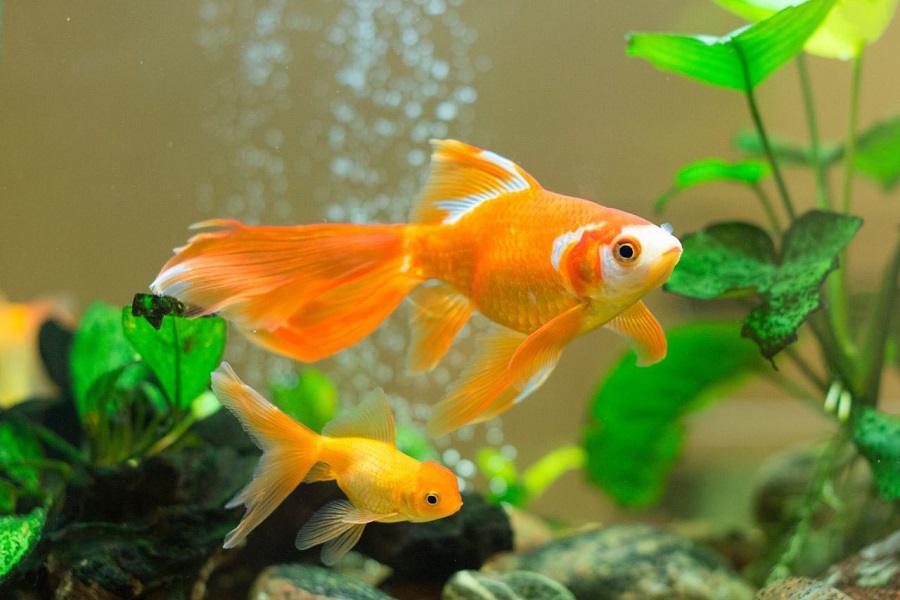The goldfish might just be the most abundant and underrated pet fish you’ll find in most people’s aquariums.
It’s one fish you can’t miss getting at your local fish store. Generally, goldfish have been split into two categories; the first one is the single-tailed variety (anal fin and single caudal), and the second is the double-tailed.
However, in China alone (where they originated from), there are over 200 varieties of goldfish.
In this article, we’re going to be looking at some of the most commonly found goldfish all across the globe.
Contents
Why Keep Goldfish?
There are many reasons why goldfish make fantastic pets. The most popular one being they don’t have a lot of maintenance needs.
Goldfish can tolerate a wide variety of water parameters. Simply put, they can tolerate a lot of your mistakes.
A common issue that most new fish owners face is overfeeding. You thought maybe water maintenance, right? Not really. Fish can easily overeat. They never stop eating, resulting in them fouling the water more quickly.
Goldfish seem to be always hungry and are voracious eaters. But, this is something you can solve once you’ve got the hang of how much you’re supposed to be feeding your fish. You should also change out around a quarter of the water in your tank every week to ensure you don’t experience any problems.
Some goldfish also don’t care much about where they’re stored or housed. The fancy type of goldfish, like the double-tailed species, are usually kept in indoor aquariums/tanks, while the less fancy ones, the single-tailed species, will thrive both outdoors and indoors.
Below are some of the most common you’ll see around:
1. Common Goldfish
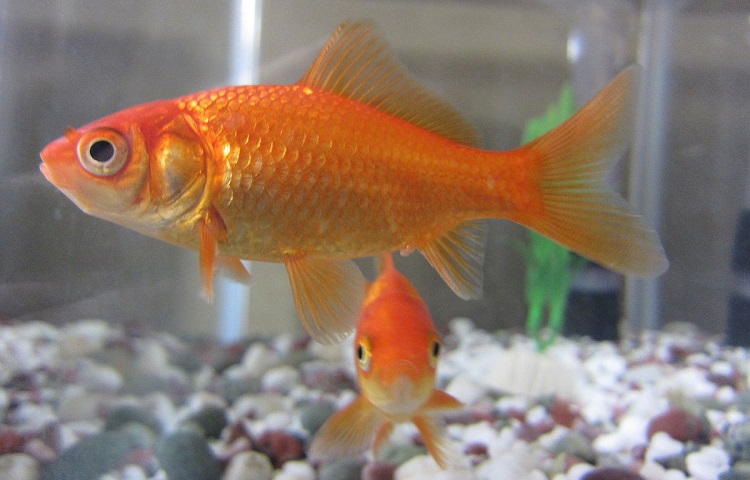
Arguably the most common of them all is the common goldfish, just like its name suggests. This type is the one that looks like its ancestors the most.
Not only do they come in a wide variety of colors; black, brown, red, yellow, orange, white, etc., they’re also plentiful and easy to keep.
Traditionally, these goldfish species were kept as cold-water fish in China. However, in recent times, they’ve proved to be very hardy fish that can live well in most water conditions they’re put in.
If you care for it properly, the common goldfish can live an incredibly long life. It’s not uncommon to hear of some of them living for up to 15 years or so.
That’s not all, though. They can grow up to around 12 inches long as well, making them quite the big fish pet once they’ve reached maturity.
2. Comet
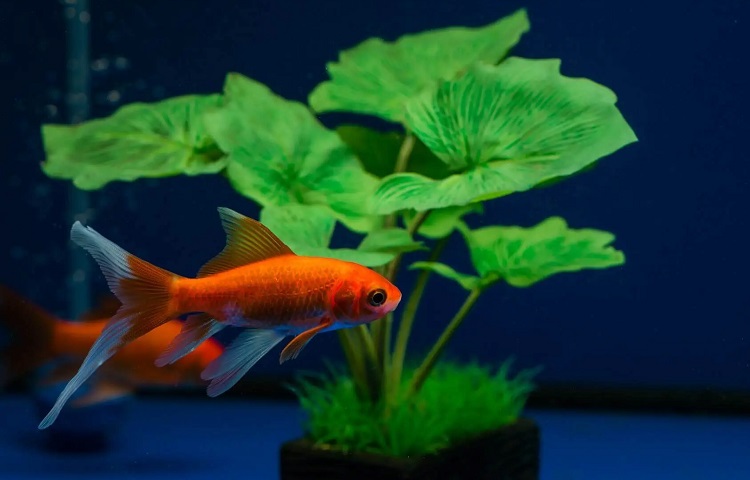
The comet is a single-tailed goldfish species that originate from the USA. Comet goldfish look a lot like their common goldfish counterparts but with much longer tails.
Comets are smaller versions and grow to around 7-10 inches when they’ve reached maturity, unlike their cousins, which grow much bigger. Comets are also low-maintenance like their common goldfish counterparts. They’re hardy fish species that are easy to keep too.
Comet goldfish do very well in ponds because of their ability to tolerate a wide variety of water conditions. You can also keep them in the same space with bigger fish pets such as koi.
But, you need to keep in mind that they’re ever ready breeders and can overpopulate any space incredibly fast.
3. Wakin and Jikin
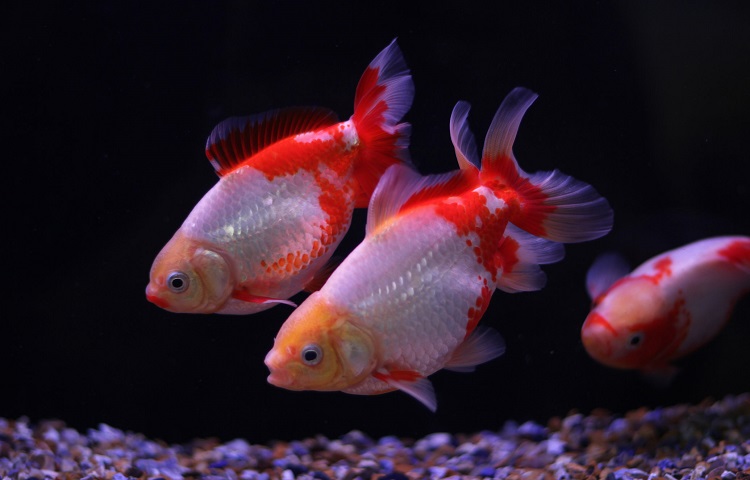
The Wakin goldfish is of the double-tailed variety and a fancy fish. It has a relatively long body with an overall athletic appearance. The Wakin, which comes from Japan, is believed to be one of the parents of the fanciest double-tailed goldfish.
This goldfish also does well in both aquariums and ponds. Furthermore, just like the other goldfish highlighted above, it also lives for a very long time. However, when kept in a pond, it dwarfs the others in size and can grow up to around 18-20 inches long.
The Jikin goldfish, just like its wakin cousin, has a long, slender body and a short tail. Although when you look at it from behind, its tail sort of has an ‘X’ shape, which is also aptly referred to as the peacock tail. The Jikin, though, has a unique feature known as ‘Rokurin’ (six scales in English).
It means the six parts of the fish that are colored red, which are the lips, ventral, pectoral, dorsal, caudal, and anal fins. While most breeders strive to get the red color, most end up getting bright orange. That said, this fish has protected fish registration, which means it’s not easy to get.
4. Fantail
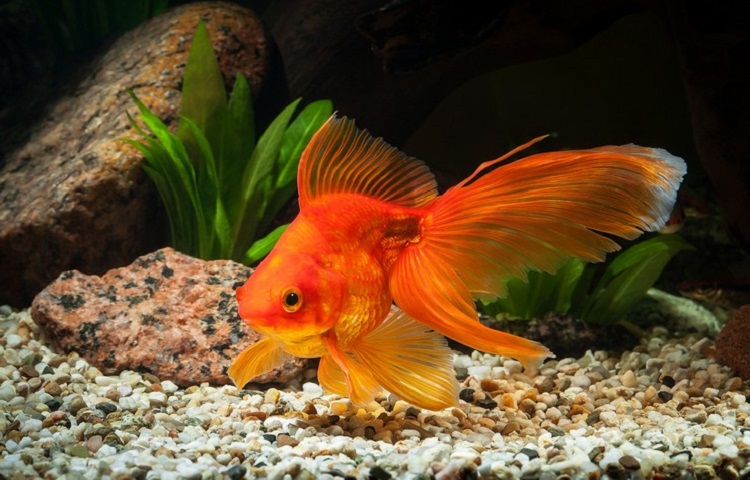
The most basic double-tailed goldfish species is the fantail. They’ve got an egg-shaped body accompanied by long trailing fins and a double tail. Some of the fantails that have longer tails are also commonly referred to as “Veiltails.”
However, they’re still known as fantails. It’s a hardy goldfish species that can survive and thrive both in an aquarium as well as a pond. They live for around 5-8 years and grow to about 6-8 inches long.
You can also get them in various color schemes, most common yellow and orange, followed by calico, white and red. It also has a docile temperament and is perfect for beginner hobbyists.
5. Telescope
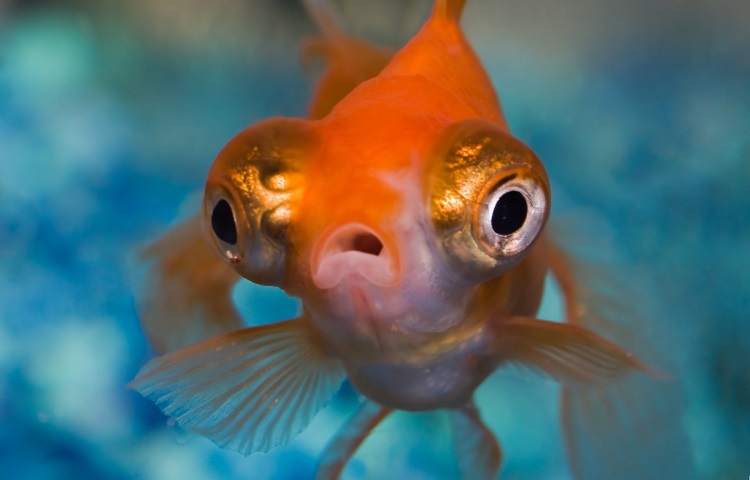
The Telescope is the goldfish species most well-recognized for its protruding eyes. They originated from China and were first bred there around the 1700s. Interestingly, their protruding eyes only start to come out once they’ve hit six months old.
However, this is a huge reason why they aren’t considered beginner-friendly. Although hardy goldfish, their eyes need to be given special attention because it gives the fish poor vision making them not compete for food.
The Telescope usually has long trailing tails alongside those protruding eyes. They’re also a much smaller size at full maturity than the other goldfish mentioned in this article. They usually get to around 5 inches long or so.
6. Oranda
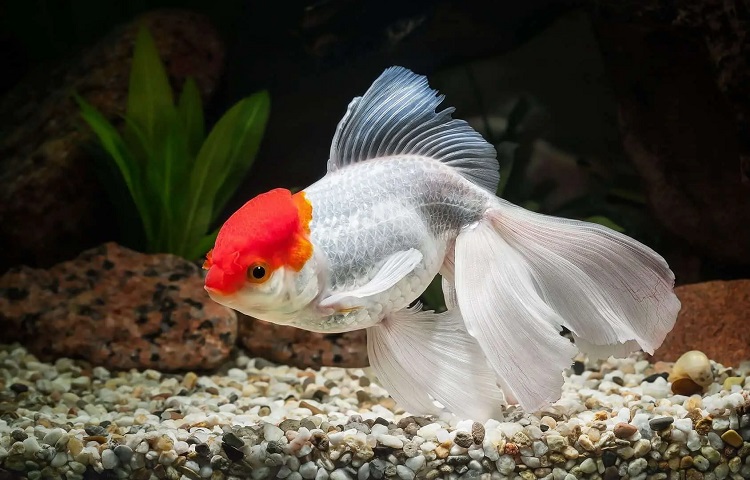
A fan favorite in the goldfish family is the oranda. Their most commonly recognizable trait is the significant growth found on their head. This growth on the head is called a hood. It’s also known as a “wen,” which in Japanese means crown.
A common nickname most hobbyists like to use when referring to this goldfish is Lionhead. They’re mostly found in Japan. They’re also one of the biggest goldfish species out there and can grow up to about 16 inches long. However, most will average around 12 inches or so.
It is more of an indoor goldfish and will do better in aquariums and fish tanks. It is because it’s highly susceptible to bacterial and fungal infections.
You can get it many color schemes, just like most of its other cousins on this list, but you’ll mainly get the “red-cap” variety, where the “wen” is bright red and bodies white or orange.
7. Pompom
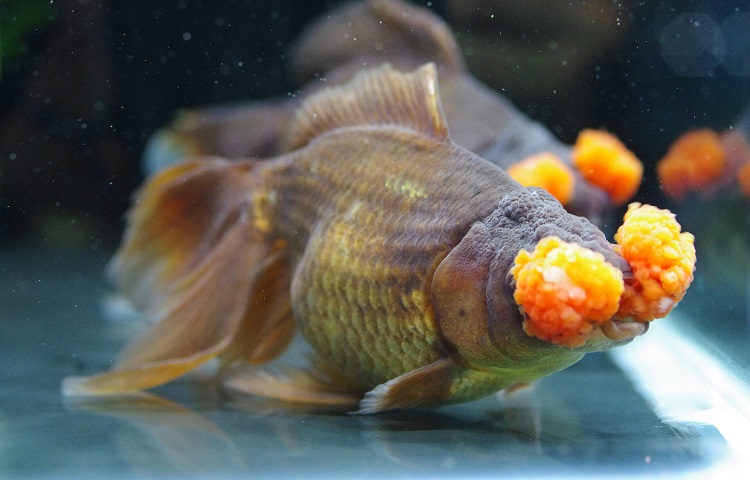
Pompom goldfish have a body shape that looks similar to the one the oranda has. The main difference between them, though, is instead of a huge growth on the head, the Pompom goldfish has a pair of gelatinous nasal growths.
These two nasal growths on their face look like two Pompoms, hence their nickname. These nasal growths start to show once the fish reaches 18 weeks old or so.
Although, they’ll take several months to form fully. With that said, even though the growths aren’t as pronounced and as big as the oranda’s “wen,” they still have a wide color variety and are highly visible.
The Pompom isn’t one of the biggest goldfish out there once it’s reached full maturity. It only grows to around 6 inches long. Like most double-tailed species of goldfish, they should be housed indoors in an aquarium or fish tank.
Why? Because their two nasal growths are highly susceptible to both bacterial and fungal infections.
Factors to Consider When Choosing the Right Tank Size for Goldfish
Selecting the right tank size for your goldfish is a critical step towards ensuring their overall well-being. Given the diverse types of goldfish, each with its unique requirements, it’s crucial to factor in several considerations when deciding on tank size. Below are the key elements to think about:
1. The Type of Goldfish
Understanding the goldfish types you plan to keep is fundamental to choosing the right tank size. Common goldfish, known for their growth range of 6-12 inches, require ample space. Typically, they are best suited for ponds or large aquariums; a 55-75 gallon tank can comfortably house two or more of these fish. On the flip side, double tail goldfish like Orandas and Fantails, which grow to be about 6-8 inches, need less space. A 20-30 gallon tank should suffice for two or more of these fancy goldfish.
Are goldfish hardy? Well, when it comes to tolerance, comets and common goldfish generally endure suboptimal environmental conditions better than their fancy counterparts. They can withstand colder water during the winter by entering a lethargic state, growing gradually larger, and even becoming invasive in some regions.
2. Water Quality
Goldfish are notorious for generating more waste than other fish species, leading to a rapid decline in water quality when housed in smaller tanks. Therefore, especially for large goldfish breeds, opt for a more spacious tank equipped with a robust filtration system. Such a setup aids in ammonia removal and sustains water clarity.

Goldfish thrive at water temperatures between 58-72°F, and bigger tanks offer better thermal stability.
3. Maintenance
While goldfish may seem low-maintenance at first glance, they actually demand regular care. The level of maintenance correlates with the number of fish and the size of the tank. Larger tanks, suitable for the biggest goldfish species, may be more cumbersome to upkeep but offer a safer and more stable environment for your finned friends.
To keep your goldfish healthy, implement weekly water changes of around 20-30%, alongside frequent water testing and cleaning to remove fish waste and leftover food
Finally, before purchasing a tank, assess your capability and willingness to commit to its ongoing care. Tailoring the tank to the specific needs of your chosen types of goldfish will go a long way in ensuring their health and happiness.
Difference Between Fancy and Non-Fancy Goldfish
Always remember that there are generally two species of goldfish. The double-tailed goldfish, the fancy one, and the single-tailed goldfish are the non-fancy ones.
Single-tailed goldfish typically have an athletic body build and are way hardier than their fancy counterparts. They’re also more affordable than the double-tailed versions and are usually categorized by most breeders as ‘feeder’ fish.
The double-tailed goldfish are categorized by their pair of caudal and anal fins. Not only are they the more popular option but, just like we’ve already mentioned, they cost way more as well.
Final Thoughts
Hopefully, now that you have an idea of the types of goldfish out there, you can start successfully keeping this kind of fish.
If you’re a beginner keeper, you might want to consider staying away from the fancy kind for now, however, have a crack at the non-fancy varieties.
All in all, we hope this article helps you get started with your goldfish keeping. So, what are you waiting for? Go get a goldfish today!

Ian Sterling, founder of Fishlab.com, began his aquarium journey over 30 years ago, driven by a deep fascination for fish and their diverse personalities. His website, Fishlab.com, is dedicated to making fishkeeping accessible and enjoyable, offering beginner-friendly guidance, expert insights, and a community for aquarists to connect and share experiences.


